
12 minute read
The study of relationships of urea groups in polyurea greases and their properties
By Vijay Deshmukh & Chetan Pagare Standard Greases & Specialities Pvt. Ltd. Mumbai, India
Abstract
The “2017 NLGI World Grease Production Survey” indicates that the production of polyurea greases is growing slowly. Its popularity as multipurpose greases in various industrial and automotive applications is growing. They are used as excellent high temperature greases in steel plants and in many automotive applications. The commercially available polyurea greases are thickened mostly with diureas and tetraureas. The properties of polyurea greases depend upon their composition and manufacturing process.
The present paper studied the relationship between the number of urea groups in polyurea grease thickeners and the grease properties. Polyurea greases thickened with different numbers of urea groups such as diurea, tetraurea, hexaurea and octaurea were prepared in the laboratory with mineral oil. These greases were tested for their major properties. The effect of number of urea groups on the properties of polyurea greases was studied and discussed.
Introduction
Although polyurea greases were known since the 1950s, their commercial production gained importance only in the early twentieth century. The major challenge in its large scale production was the handling and storage of toxic and hazardous raw materials used for their production. Even now the production of polyurea greases is restricted to a few major companies.
Polyurea greases have excellent high temperature properties and oxidation resistance. The absence of any metal ion in polyurea greases give them excellent oxidation stability and thereby very long life. These greases have very good water resistance and corrosion resistance properties. Their flow properties are also good and, hence, they are most suitable for centralised lubrication systems.
These properties make them a very good choice for high temperature applications in steel plants especially in continuous casting applications. Special thermostable polyurea greases were developed for such applications, which resulted in improvement in lubricity and reduction in wear and damage of bearings. (1) Polyurea greases are also popular for automotive applications such as wheel bearings, CV joints, ball joints, brake callipers, etc.
There are many patents on polyurea greases regarding their composition and method of preparation. (2-10). Normally, polyurea greases are prepared in open kettles. But it has been shown that polyurea greases can also be prepared in Stratco Contactor reactors. (11)
The major components of polyurea grease are isocyanates and amines. By using different combinations of aliphatic or aromatic isocyanates and various amines, polyurea greases with desired properties can be produced. Thus, polyurea chemistry offers an opportunity to develop thickeners for greases with diverse properties. (12)
The major drawback of polyurea greases is their incompatibility with other high temperature greases such as lithium complex, aluminium complex and calcium sulphonate complex greases. However, new polyurea greases that have improved compatibility with lithium complex and calcium sulphonate complex greases have been developed. (13)
Polyurea greases also tend to harden as a result of long exposure to high temperatures. This causes problems in their use in centralised lubrication systems where this property leads to pipeline choking and, finally, bearing failures. However, this problem can be avoided by suitable modifications in polyurea grease composition. (14)
Commercially, the most popular polyurea greases are thickened with diureas and tetraureas. These are prepared using isocyanates, primary amines and secondary amines. Depending upon the formulation and processing conditions, polyurea greases with different urea groups can be prepared. The typical structures of diurea, triurea and tetraurea molecules are shown below.
The major advantage of polyurea greases over soap thickened greases is their strong hydrogen bonding among the urea groups, which results in highly stable structure, in contrast to the soap thickened greases where the molecular interactions are dominated by weak Van der Waal forces. The hydrogen bonding in polyurea grease is shown below.
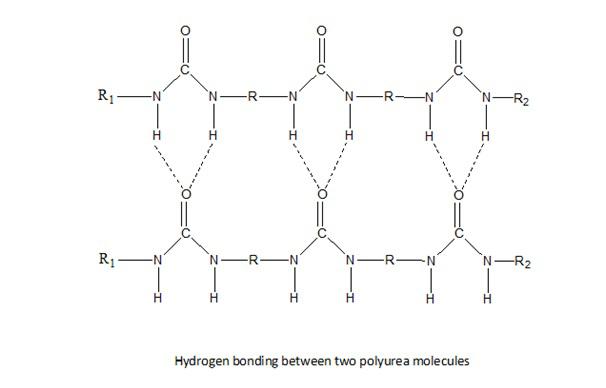
Polyurea greases attracted the attention of grease manufacturers and users following the recent price hikes and limited availability of lithium hydroxide all over the world. Polyurea greases were evaluated and compared with other high temperature greases such as lithium complex, aluminium complex and calcium sulfonate complex greases. It was observed that polyurea greases could be an ideal cost effective replacement for long life lithium and lithium complex greases. (15)
The properties of polyurea greases greatly depend on their composition, structure and method of manufacture. In this paper, the authors prepared polyurea greases thickened with different urea groups and studied their properties.
Experimental
Polyurea greases were prepared using isocyanates and amines. The base oil used was a Group I mineral oil with properties given in Table 1. The conventional process of making polyurea grease was used. The completion of reaction was checked using FTIR. The following four polyurea greases were prepared.
1 Diurea, 2 Tetraurea, 3 Hexaurea and 4 Octaurea
For preparing these greases, stoichiometric quantities of isocyanates and amines were used to make the desired number of urea groups such as diurea, tetraurea, hexaurea and octaurea. The completion of the reaction was ensured with the help of FTIR. Figure1 gives FTIR spectra of these four polyurea greases. The amine peaks were observed around 3,300 cm¯¹. The broad peaks of NH association through hydrogen bonding also confirmed strong hydrogen bonding in these polyurea greases.
The thickener content in all the greases was maintained at around 15.3 % for better comparison of their properties. No additives were used in any of these greases. All the greases were milled under the same conditions of milling and at the same temperature.
During preparation of these greases in the laboratory, all the required precautions were taken for the safe handling and storage of hazardous isocyanates and amines. The hazardous chemicals were stored separately. The batches were prepared in a fume hood with proper exhaust facilities. Once the reaction was complete, the polyurea grease was safe to handle. Suitable personal protection equipment (PPE) was used during the preparation of laboratory batches.
All the greases were tested as per ASTM test methods such as D217, D566, D2265, D6184, D4048, D1264 and D4290. In addition, these greases were also tested for their shear reversibility and high temperature hardening properties. There are no standard procedures to determine these two properties and, hence, in-house test procedures were used for checking these properties. The details of these tests are given below.
Shear Reversibility Test
Polyurea greases are known to have an inherent shear reversibility property. When sheared, these greases soften as do conventional soap based greases. However, as soon as the shearing force is removed, polyurea greases tend to regain their consistency.
In this study, the following test was used to check the shear reversibility tendency of polyurea greases. The worked penetration was measured at 25 C after 60 strokes and after 10,000 double
strokes. The grease cup was kept in the cup and after 15 min, the penetration was again determined without disturbing the grease. Then, after waiting periods of 30, 60 and 120 min following the first penetration, the penetration was determined again. These penetration figures were noted and reported.
High Temperature Hardening Test
An in-house test was used to determine the tendency of the grease to harden on exposure to high temperatures. Although, polyurea grease has many superior properties, it has an inherent tendency to harden on long exposure to high temperatures. So, in many high temperature applications such as those in Steel Melting Shops (SMS), polyurea greases can harden, which leads to choking of pipelines and failures of bearings. (16)
In this study, an in-house test revealed the effect of urea groups on the hardening property of various polyurea greases. In this test, the unworked penetration of grease was determined by the ASTM D217 test. Then, the same cup of grease was placed in an oven at 200 C for two hrs. After two hrs, the cup was taken out of the oven and kept at room temperature for 3 hrs so that it came to room temperature, and the unworked penetration was determined. The penetration after heating in an oven revealed the tendency of the grease to harden on exposure to high temperatures.
Results And Discussion
Consistency- All the samples were tested for unworked penetration and worked penetration after 60 and 100 K strokes. The results are given in Table 2.
The difference in worked penetration after 60 and 100 K strokes indicates the shear stability of the grease. The results of this study indicated that the difference in worked penetration after 60 and 100 K strokes increased with the number of urea groups. This showed that the shear stability of these polyurea greases decreased with greater number of urea groups.
Roll Stability
Table 3 reports the roll stability test results of polyurea greases. It was observed that the percent change in penetration after the roll stability test increased from diurea grease to hexaurea grease. In octaurea grease, the change did not uniformly increase. These data showed similar trends in the 100 K penetration test, which indicated that the shear stability of polyurea greases decreased with the greater number of urea groups.
Dropping Point
The dropping points of these greases are given in Table 4. The dropping point of tetraurea grease was highest. For hexaurea and octaurea greases, the dropping points were lower than tetraurea grease but higher than diurea grease.
The manufacturing process along with the composition of the grease greatly influences the dropping point of polyurea greases. The dropping point depends upon the rate of heating, the maximum temperature and the time the batch is maintained at this temperature during the manufacture of the grease. The process requirements for the manufacture of these greases could be different to get the best possible product.
Leakage Tendency
The leakage tendency of polyurea greases was determined by ASTM D4290 under accelerated conditions. The results are given in Table 5. The leakage tendency was low for all four polyurea greases. However, the results indicated that the leakage tendency deteriorated as the number of urea groups increased. These results were in line with the observations made on shear stability and roll stability test results.
Heat Stability
The oil separation test data as per ASTM D6184 are given in Table 6. The oil separation in all the cases was very low. The oil separation reduced as the urea groups increased.
Shear Reversibility
The shear reversibility data are shown in Tables 7 and 8. Shear reversibility was tested after 60 and 10 K strokes. The data shows that all the polyurea greases exhibited shear reversibility, but the degree of shear reversibility varied with the number of urea groups. The best results were obtained with the octaurea grease.
High Temperature Hardening
Polyurea greases have an inherent tendency for hardening on long exposure to high temperatures. This property plays an important role especially in high temperature applications. This hardening tendency of polyurea greases results in bearing failures due to hardening of grease in bearings. In centralised lubrication systems it also leads to pipeline blockages. Improved polyurea greases have been developed where by this hardening tendency has been reduced considerably.
In this study, the effect of urea groups in polyurea greases on their hardening tendency was studied using an in-house high temperature hardening test. The results are shown in Table 9 The results in Table 9 seemed to indicate that the hardening tendency of polyurea greases on exposure to high temperatures was reduced as the number of urea groups in polyurea grease increased.
Water Wash Out
The water washout test results are given in Table 10. The water washout test indicated that the water resistance of all the four polyurea greases was good. All four greases showed excellent water resistance properties.
Conclusions
This study measured the properties of polyurea greases thickened with different urea groups. The results of this limited study were based on polyurea greases prepared with typical isocyanates and amines. It was observed that the properties of polyurea greases varied with number of urea groups present (diurea, tetraurea, hexaurea and octaurea)
Further detailed study on polyurea grease thickener structures and their influence on grease properties are needed. Use of the analytical techniques such as SEM, TEM, mass spectroscopy, etc. will help to understand the behaviour of different polyurea greases.
Fig.1 FTIR spectra for polyurea greases
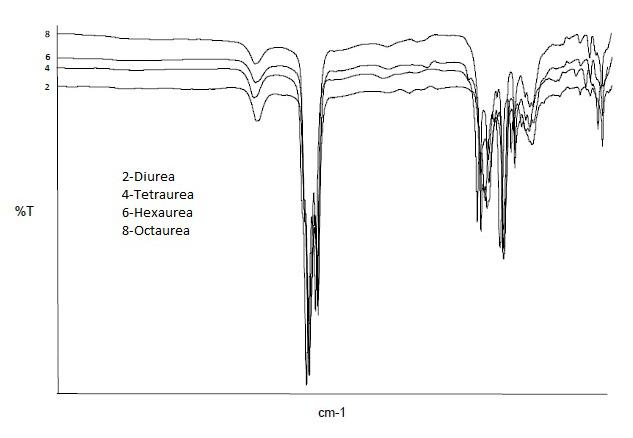
Table 1 Base Oil Characteristics

Table 2 Consistency Test Results
Table 3 Roll Stability Test Results



Table 5 Accelerated Leakage Tendency Test Results
Table 6 Oil Separation Test Results

Table 7 Shear Reversibility Test Results (after 60 strokes)
Table 8 Shear Reversibility Test Results (after 10 K strokes)
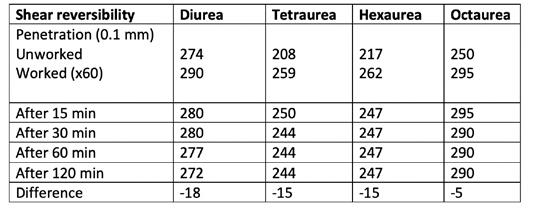

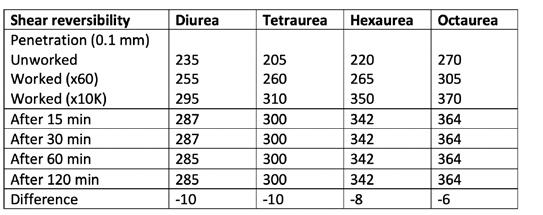
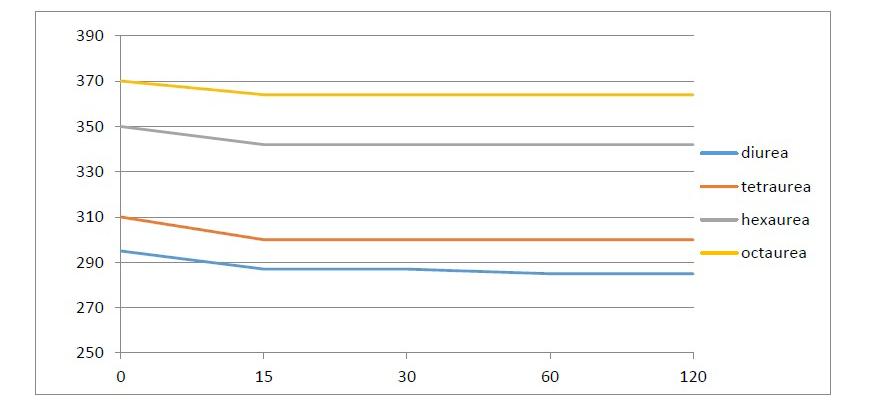
Table 9 High Temperature Hardening Test Results

Table 10 Water Washout Test Results

Acknowledgements
The Authors are thankful to the management of Standard Greases & Specialities Pvt. Ltd. for the permission to present this paper at the 85th NLGI Annual Meeting, 2018.
References
1 “Development of new urea grease for steel continuous casting machine under boundary lubrication” by S. Nakajima, et al., presented at the NLGI Annual Meeting, 2003. 2 US Patent 4,661,276 3 US Patent 4,436,649 4 US Patent 5,314,982 5 US Patent 5, 523,009 6 US Patent 5,554,586 7 US Patent 5,145,591
8 US Patent 5,238,589 9 US Patent 5,246,605 10 CN, China Patent 102504920B 11 “Manufacture of polyurea greases in Stratco Contactor Reactor” by G.P. Newsoroff, presented at the NLGI Annual Meeting, 2013. 12 “Next generation long life polyurea greases” by T.T. Nadasdi, presented at the NLGI Annual Meeting, 2000. 13 “Robust polyurea grease for wide range of industrial applications” by Dr. Anoop Kumar, et al., presented at the 12th NLGI-India Chapter Annual Meeting, 2010. 14 “Effect of preparation process on elevated temperature tribological properties of composite polyurea grease” by Z. Shen, et al., Industrial Lubrication and Tribology, Vol.68, Issue 5, pp 611616, 2016.
Moly Di Sulfi de
• One of the World’s leading MoS2 producers • Producer based in India • Best quality as per International standard available at competitive price. • MoS2 powder is one of the best solid lubricants. • Widely used as Extreme Pressure Additive in
Moly grease, paste, sprays & coatings. • Available in different micron particle size • Tech Grade • Technical Fine Grade • Super Fine Grade
Distributors Wanted
www.moly.in exports@moly.in
ISO 9001:2005
WE WANT YOUR INPUT!
Please click the survey link below let us know how we can improve the NLGI Spokesman.





